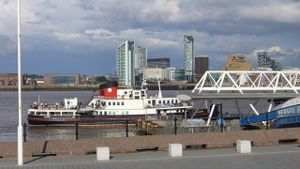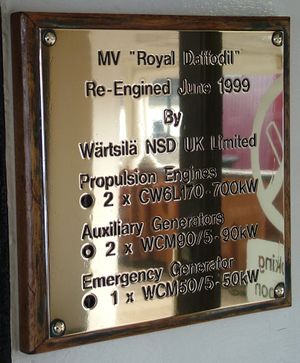MV Royal Daffodil
| |
This article needs additional citations for verification. Please help improve this article by adding reliable references. Unsourced material may be challenged and removed. (November 2007) |

The MV Royal Daffodil is a ferry in operation on the River Mersey, England and is currently the flagship vessel of the three Mersey Ferries. From launch until a major refit in 1998, she was named MV Overchurch, she began service for Birkenhead Corporation Ferries in 1962, and was withdrawn by Mersey Ferries in 1990 where she saw minimal active work until 1999, when she was extensively refurbished. Despite her extensive re-build, the ship still retains a similar profile.
Contents
MV Overchurch
The vessel was built for Birkenhead Corporation in 1962 at Cammell Laird, Birkenhead. She was named after one of the town's post-war overspill housing developments.[1]
The ferry was the first of the fleet to be of all-welded construction and she is currently the last Mersey Ferry to be built. The Overchurch was popular with its Captains and Mates as its navigation bridge spanned the whole ship, rather than having a wheelhouse and side cabs such as Mountwood and Woodchurch used. The wheelhouse was spacious with a single binnacle and brass wheel. Most of the ships control instruments were fitted into specially built stand alone units, including the telegraph heads. This was unlike the compact and relatively cluttered bridges on the Overchurch's two near sisters, where most of the instruments were attached to the bulkheads. It was a handsome vessel, with clean and smooth lines and a stout funnel. Her original livery was Birkenhead's orange and black funnels, with a flame red band above the rubbing strake.
The Overchurch contained identical navigation equipment and engines to Mountwood and Woodchuch, however, with a gross tonnage of 468,[2] the ship was slightly heavier that its two near sisters and was therefore a knot or two slower. The original plan was to have a third ferry built to the designs of Mountwood and Woodchurch, however, Birkenhead Corporation decided to design a completely new vessel.
Overchurch was fitted with a small deck area just behind the bridge and around the rakish funnel. The funnel was joined to the bridge at the front and was quite high, giving the ferry a top heavy look. There were also sheltering bulkheads beneath the bridge wings. The reason for these is that Overchurch could be fitted with awnings for rough weather or heavy rain. When built, she was somewhat more advanced than the two sisters. As well as the completely enclosed navigation bridge, she also had a more advanced radio system, a loudaphone system, three window-wipers and an automatic whistle control.
Engines
The two medium speed Crossley diesel engines were controlled via three Chadburns Synchrostep telegraph pairs, one on each wing and one central, the same as Mountwood and Woodchurch, although the telegraphs differed in that just the heads were fitted into specially built units in the bridge wings and midship. Unlike most other telegraphs which had simple commands of slow, half, full etc, she had more speed options both ahead and astern e.g. half 1,2,3,4,5 full 1,2,3,4,5 giving much more control of speed on the busy river. Overchurch was almost always operational from 1962 up until the early 1990s having not been withdrawn for major overhauls as Mountwood and Woodchurch were. The Overchurch is the most common ferry on photographs of these periods.
In service
Her first official duty was in 1962, when she conveyed Princess Alexandra to open the new Cammell Laird dry dock.[2]
The Overchurch was a popular ferry with passengers and was described as "the warm one" by many familiar with her. Why she was warmer is unknown. Overchurch was operational throughout the late 1960s where cost cutting enforcements meant that her sisters Mountwood, Woodchurch and former Wallasey boats Leasowe and Egremont were docked in the East Float for some considerable time. Overchurch and the larger Royal Daffodil and Royal Iris operated the service.
Overchurch was chosen to operate a new service to Otterspool Promenade during the 1984 International Garden Festival, when all the ferries were given a new livery of red white and blue, replacing the black and green livery given in the mid 1970s. She operated alone throughout the Mountwood and Woodchurch refurbishment, her last full season was 1989.[1]
In 1991, she was used until the two sisters returned in time for the QE2's first visit to Liverpool. She was then placed as a standby vessel, ready in case one of the two sisters broke down. This had a somewhat detrimental effect on the ferry. Mountwood and Woodchurch were reliable boats and worked on an interchanging rota with around two weeks of operational service and then two weeks of repairs and maintenance. This meant that the Overchurch underwent lengthy periods of disuse, being laid up in the East Float of Birkenhead Docks. It is unknown why this was the case, as she was suitable for active service.
During 1997, Overchurch was used several times. The age of the ship and lack of serice was apparent: the decking was green, the engines billowed thick black smoke and streams of soot ran down the funnel. Why her engines were in such a poor state is likely to be due to lack of operation and also heavy usage during the 1980s. Without a doubt, the ferry's age was showing.
Refurbishment
The Overchurch was given her major refit in 1998 at Lengthline Ship Repairers in Manchester, which resulted in a major rebuilding of all decks. Her funnel and bridge were removed and placed in storage. the rest of her superstructure was modernised and refurbished. New engines and navigation equipment were fitted and the resulting transformation was spectacular. Her original funnel and bridge, including binnacle and brass helm, were retained, albeit with some minor additions.
MV Royal Daffodil
She was re-named Royal Daffodil and was back in service by 1999. Yet, close examination of her bows and stern, the name "Overchurch" can still be seen beneath the black paint. The Royal Daffodil changed considerably from her previous guise. The lower main and forward saloons were gutted and extensively re-built, spanning to whole width of the ship. Catering and bar facilities were installed plus fabric seating, carpets and tables and chairs. The upper saloon was also enclosed and extended, with a dance floor fitted and another bar area. The bridge deck was also extended to the full width of the ship. Immediately behind the bridge a small crew room was installed. Below decks there is another large dance floor in the former smoke room and there is crew accommodation at the stern of the vessel. The engine room was completely gutted during the refit, and major re-structuring work took place within it. The new engines were fitted further back to allow greater space around them for additional machinery. The engine room also contains a control centre which includes a set of telegraphs, a large switch board and radar screen. The main deck stairwell was also covered over with a shelter-like structure.
Royal Daffodil is often used for functions and party or special cruises. Her rebuild differed from the other ships in the fleet, as she was re-built primarily for cruising. Whereas, the Mountwood (Royal Iris of the Mersey) and the Woodchurch (Snowdrop) have been re-built as standard multi-purpose ferries.
Near Miss
On the 23rd October 2009, the Royal Daffodil was carrying a full load of passengers to witness the aviation display to celebrate the visit of HMS Illustrious to the Mersey. The ferry appeared to be on a direct course across the bows of the approaching oil tanker Ramira. Evasive action was taken by both vessels after the Ramira sounded her whistle. Some passengers were shocked and upset but nobody sustained any injuries. An investigation is currently underway.
References
- ↑ 1.0 1.1 Maund, TB (1991). Mersey Ferries - Volume 1. Transport Publishing Co. Ltd. ISBN 0-86317-166-4.
- ↑ 2.0 2.1 Emmerson, JC (1982). The Mersey At Work: Ferries. Countryvise Ltd. ISBN 0-907768-35-0.

